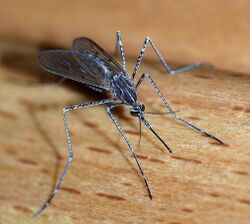Biology:Culiseta
| Culiseta | |
|---|---|

| |
| Culiseta longiareolata | |
| Scientific classification | |
| Domain: | Eukaryota |
| Kingdom: | Animalia |
| Phylum: | Arthropoda |
| Class: | Insecta |
| Order: | Diptera |
| Family: | Culicidae |
| Genus: | Culiseta Felt, 1904[1] |
Culiseta is a genus of mosquitoes. Most Culiseta species are cold-adapted, and only occur in warmer climates during the colder parts of the year or at higher elevations where temperatures are lower. Species found in Southern California are larger than most mosquitoes species, specifically Cs. inornata, Cs. particeps, and Cs. incidens. These species are found throughout the year in Southern California and feed on several vertebrate species, such as birds, livestock, rodents, reptiles, and humans.[2][3] The larvae of most species are found bogs, marshes, ponds, streams, ditches, and rock pools, but an African species occurs in tree holes ("phytotelmata"), a common eastern Palaearctic species occurs in water wells and rock pools, and several Australian species occur under ground. Little is known about the blood-feeding habits of females. Most species feed on birds and mammals, but a few feed on reptiles. Several species attack domestic animals and occasionally humans,[4] and some species are pollinators.[5]
Culiseta species are found throughout the world, except in South America.[4] Two extinct species are known from the Eocene Kishenehn Formation in Montana[6]
Species
Subgenus (Culiseta) Felt, 1904
- Culiseta alaskaensis (Ludlow, 1906)
- Culiseta annulata (Schrank, 1776)
- Culiseta atlantica (Edwards, 1932)
- Culiseta bergrothi (Edwards, 1921)
- Culiseta glaphyroptera (Schiner, 1864)
- Culiseta impatiens (Walker, 1848)
- Culiseta incidens (Thomson, 1869)
- Culiseta inornata (Williston, 1893)
- Culiseta megaloba Luh, Chao and Xu, 1974
- Culiseta niveitaeniata (Theobald, 1907)
- Culiseta particeps (Adams, 1903)
- Culiseta subochrea (Edwards, 1921)
Subgenus (Allotheobaldia) Brolemann, 1919
- Culiseta longiareolata (Macquart, 1838)
Subgenus (Austrotheobaldia) Dobrotworsky, 1954
- Culiseta littleri (Taylor, 1914)
Subgenus (Climacura) Howard, Dyar and Knab, 1915
- Culiseta antipodea Dobrotworsky, 1962
- Culiseta marchettei García, Jeffery and Rudnick, 1969
- Culiseta melanura (Coquillett, 1902)
- Culiseta novaezealandiae Pillai, 1966
- Culiseta taiwanica Lien, Lin and Weng, 1999
- Culiseta tonnoiri (Edwards, 1925)
Subgenus (Culicella) Felt, 1904
- Culiseta amurensis Maslov, 1964
- Culiseta atra Lee, 1944
- Culiseta drummondi Dobrotworsky, 1960
- Culiseta fumipennis Stephens, 1825
- Culiseta inconspicua Lee, 1937
- Culiseta litorea Shute, 1928
- Culiseta minnesotae Barr, 1957
- Culiseta morsitans Theobald, 1901
- Culiseta nipponica La Casse and Yamaguti, 1950
- Culiseta ochroptera Peus, 1935
- Culiseta otwayensis Dobrotworsky, 1960
- Culiseta sylvanensis Dobrotworsky, 1960
- Culiseta victoriensis Dobrotworsky, 1954
- Culiseta weindorferi Edwards, 1926
Subgenus (Neotheobaldia) Dobrotworsky, 1958
- Culiseta frenchii (Theobald, 1901)
- Culiseta hilli (Edwards, 1926)
Subgenus (Theomyia) Edwards, 1930
- Culiseta fraseri (Edwards, 1914)
Children with Uncertain Position
- Culiseta arenivaga Marks, 1968
- Culiseta wui Lin, Tseng and Lien, 2008
Extinct species
- †Culiseta gedanica Szadziewski & Gilka, 2011
- †Culiseta kishenehn Harbach & Greenwalt, 2012
- †Culiseta lemniscata Harbach & Greenwalt, 2012
References
- ↑ "Nematocera by Markku Savela". Lepidoptera and some other life forms. http://www.funet.fi/pub/sci/bio/life/insecta/diptera/nematocera.
- ↑ Identification of the Mosquitoes of California. Richard Meyer and Stephen Durso, Mosquito and Vector Control Association of California. 1998.
- ↑ Sandhu TS, Williams GW, Haynes BW, Dhillon MS. Population dynamics of blood-fed female mosquitoes and comparative efficacy of resting boxes in collecting them from the northwestern part of Riverside County, California. J Global Infect Dis [serial online] 2013 [cited 2013 Oct 22];5:15-8.
- ↑ 4.0 4.1 "GENUS Culiseta". The Walter Reed Biosystematics Unit. http://wrbu.si.edu/GeneraPages/culiseta.htm.
- ↑ Peach, Daniel A. H.; Gries, Gerhard (2019). "Mosquito phytophagy – sources exploited, ecological function, and evolutionary transition to haematophagy" (in en). Entomologia Experimentalis et Applicata 168 (2): 120–136. doi:10.1111/eea.12852. ISSN 1570-7458.
- ↑ Harbach, Ralph E.; Greenwalt, Dale (2012-10-30). "Two Eocene species of Culiseta (Diptera: Culicidae) from the Kishenehn Formation in Montana". Zootaxa 3530 (1): 25. doi:10.11646/zootaxa.3530.1.2. ISSN 1175-5334.
External links
- "Mosquitoes of California". Alameda County Mosquito Abatement District. http://www.mosquitoes.org/Culiseta.html.
- "New Jersey's 63 Mosquitoes". New Jersey Mosquito Homepage. http://www-rci.rutgers.edu/~insects/njspp.htm.
- Fatma K. Adham; Leaf, HL (December 1982). "Establishment of a colony of the mosquito Culiseta longiareolata under laboratory conditions". Cellular and Molecular Life Sciences 38 (12): 1498–1499. doi:10.1007/BF01955792. OCLC 14209071. PMID 6129996.
- Culiseta melanura, black-tailed mosquito on the UF / IFAS Featured Creatures website.
Wikidata ☰ Q539729 entry
 |


